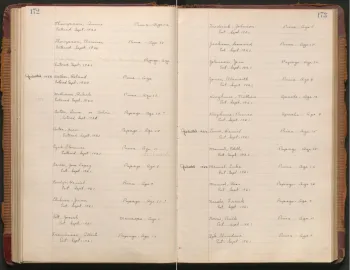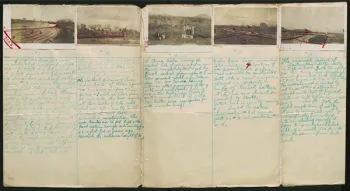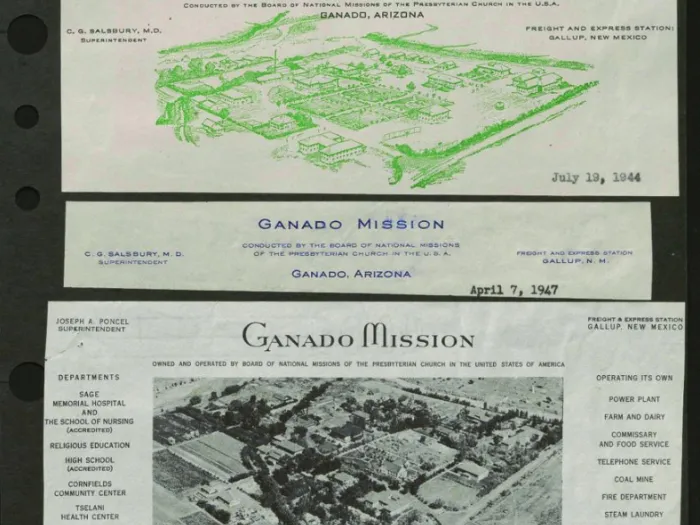Tucson Indian Training School students ready to leave for a basketball game off campus, Spring 1937. Pearl ID: islandora:362723
--by Elaine Shilstut, Nick Skaggs, and Allison Davis
In 1906, an 8-year-old Akimel O'odham (Pima) student named Annie Moore enrolled at the Tucson Indian Training School. “We were not allowed to speak the Pima tongue at school,” Moore would recall almost 70 years later in her autobiography A Pima Past. “Some students would report on those who spoke in Indian, and as a punishment our mouths would be taped.”
Prompted by United States Secretary of the Interior Deb Haaland, the United States government is reckoning with its role in separating Indigenous children from their families and using education as a tool to eradicate their language, culture, and way of life. Churches, including the PC(USA), are also confronting their complicity in erasing Indigenous customs and spiritual practices and replacing them with an ethnocentric version of the Christian faith. Like other denominations, Presbyterians operated residential boarding schools funded by government subsidies, and, in the late 1890’s, independent of government support.

Tucson Indian Training School students work in the field, circa 1930-1940. Pearl ID: islandora:362709
In winter of 2023, when we at the Presbyterian Historical Society (PHS) Reparative Description Committee were auditing archival collection guides for harmful and oppressive language, the records of the Tucson Indian Training School (Record Group 103) caught our attention. As we wrote in our first blog post on the topic, reparative description is the practice of critically examining and ultimately adjusting the way we as an institution describe or characterize marginalized groups, paying particular attention to instances where our description inflicts harm, spreads false narratives, or minimizes past and ongoing injustices. In reading the original collection guide, we immediately recognized outdated terms were used to refer to the Akimel O'odham (Pima) and Tohono O’odham (Papago) people, but, upon further reflection, noted that the lived experiences of these Indigenous groups were erased and misrepresented through omission and under-description rather than through outdated language alone. The use of a neutral voice glossed over government and church policies of assimilation and cultural destruction and left out students’ points of view.
In repairing the collection guide's text, we would need to open space for additional voices in telling the story. Each student undoubtedly had a unique experience at Tucson. Did the records provide a more complete picture into how they may have experienced their education? Who were the first students? What were their ages? How did the school administration perceive them, and how did they perceive the administration?

Tucson Indian Training School students slicing tomatoes, circa 1940-1950. Pearl ID: islandora:362848
Tackling this collection after our revision of Record Group 37 (which contained the records of two corporate entities: The National Japanese American Student Council and the PCUSA Board of Christian Education’s Department of Colleges and Theological Seminaries), we followed the steps of our reparative description workflow. First, we placed the original text into a shared document to add questions, comments, and reminders to verify certain assertions related to the administrative history of the school. Rarely is reparative work as simple as finding harmful and biased terms and swapping them for language that is vetted by the described community. We concluded that making changes around the edges was insufficient, and a wholesale revision of the guide was warranted. Upon Googling the Tucson School, we noticed our collection guide among the top results and felt a responsibility, as stewards of the school’s records, to contribute a fuller, more accurate descriptive history. This meant reviewing the 10 cubic feet of the physical collection was unavoidable, especially as we hoped to uncover the perspectives of the enrolled students.

Page from one of the last issues of "Escuela News," a Tucson Indian Training School periodical, before the School closed. RG 103, Box 1, Folder 32. Pearl ID: islandora:370335
A crucial element of reparative description is the research required at the onset to familiarize oneself with the subject matter at hand. The collections at PHS are vast and expansive, documenting a wide array of topics covering the history of the Presbyterian and Reformed tradition in America. Our research involved consulting published literature and archival materials from our own collections to learn about Presbyterian missionaries and Indigenous peoples residing in Tucson, Arizona in the 19th and 20th century. These included theses, biographies, pamphlets, newspapers from the time period, and the contents of biographical vertical files of each superintendent. We learned that the bulk of records directly related to the administrative history of the school were housed at another institution (Arizona Historical Society), so our reconstruction of the school’s operational and administrative history came together largely from sections of another collection held by PHS, Record Group 301.7 (United Presbyterian Church in the U.S.A. Board of National Missions Department of Mission Development Records, SERIES I, Subseries 8).
Amalia Cottrell (Archives Technician) digitized the contents of other collections so we could develop a more complete picture of the school’s founding, the unique tenure of each superintendent, and the challenges the school faced over its existence. We relied on direct quotations whenever possible to anchor the story in the voices of teachers, superintendents, and students. Unfortunately, finding student perspectives proved challenging, so we extended our research outside our collections and considered other ways to enhance description of student-related information.

Pages from Tucson Indian Training School register, 1888-1952. RG 103, Box 10, Folder 6. Pearl ID: islandora:360142
Nick Skaggs (Processing Archivist) brought in additional PHS staff members (Amalia Cottrell and Maura Weil, Archives Technicians; David Staniunas, Records Archivist; and Kyna Herzinger, Records Manager) to enhance the description of more than 1000 student files in Series IV and V. Knowing that Indigenous students’ names have been inconsistently and inadequately recorded, sometimes under aliases or with traditional names misspelled, staff verified and transcribed the students’ full names and tribal affiliations from their original applications, added date ranges for materials contained in each folder, and noted the presence of photographs and personal correspondence, when applicable, on the physical folder titles and in the collection inventory online. We hope that this enhanced description will aid in the discoverability of the records and prove useful for researchers conducting genealogical research.
Series VI contains the Tucson Indian Training School register, which documents names of enrolled students, dates they entered the school, and their ages upon entry. Amalia Cottrell digitized the 258-page register, and Nancy Polhamus, PHS volunteer, transcribed the entries to provide access to many more names than are represented by the student files in Series IV and V. This is where we were able to verify the attendance of 8-year-old Annie Moore Shaw, author of A Pima Past, in September 1906, and, one year prior, her older brother, Willie, on September 7, 1904.

Notes and photographs documenting the replacement of the Tucson Indian Training School's well motor, which was completed using the labor of Indigenous students. RG 103, Box 1, Folder 24. Pearl ID: islandora:368273
As is sometimes the case with older collection guides, important elements of description are missing and need to be created from scratch. The original guide lacked description of the collection’s scope and content (this is called the “collection overview” in PHS collection guides). We reviewed the physical contents of the collection to create the general collection overview and the more specific series descriptions (series names were present in the old guide but not adequately described). We surveyed and recorded the dates and types of materials included (e.g. correspondence, property records, photographs, reports). During this work, we found records pertaining to the flooding of the Santa Cruz River (circa 1919 to 1920), including notes with photographs documenting work performed on the school's well motor, which was dug out and replaced almost entirely by student manual labor.
With the narrative text revised and the collection overview created, we turned our attention to controlled vocabulary in the form of Library of Congress Subject Headings (LCSH). Like most libraries and archival institutions in the United States, PHS uses standardized subject headings from the Library of Congress (LC) across all records and guides to link similar topics and enhance discovery. Some of these headings are outdated, insensitive, and offensive, such as the current subject heading for Indigenous peoples in the United States (“Indians of North America”) and for the Akimel O'odham (Pima) and Tohono O’odham (Papago) people (“Pima Indians” and “Tohono O'odham Indians”).

Students playing, circa 1930-1940. Pearl ID: islandora:362728
The Library of Congress is currently making holistic changes to subject headings related to Indigenous peoples of the Americas, but the process is time intensive because it is being conducted in consultation with the described Indigenous communities. Not willing to wait for LC to complete their revision (which could take years or decades), some libraries have moved away from relying exclusively on LCSH to adopting local headings in their discovery systems. The Reparative Description Committee proposed that PHS move in a similar direction and drop the term “Indian” within subject headings in reference to Indigenous peoples. When describing specific tribes, we seek guidance from the National Museum of the American Indian Culture Thesaurus (NMAICT). When we depart from Library of Congress Subject Headings in favor of local terminology, we record and connect the former term and its equivalent in our terminology crosswalk. When making this change, we also make our intervention visible by using a standardized note stating that the record was edited as part of ongoing revision of outdated or harmful language in cataloging.
Once all changes were agreed upon, we shared our repaired draft and legacy collection guide with other staff at our institution and solicited feedback. We recognize that we are limited by inherent biases in doing reparative work because we are non-Indigenous, white, cisgender individuals working within a predominantly white institution and do not belong to the communities we are describing.

Tucson Indian Training School students, circa 1930-1940. Pearl ID: islandora:362692
Perhaps the most challenging part of doing this work is creating meaningful and respectful partnerships with the communities we are describing, because building relationships and establishing trust takes time and resources, especially when those communities are not local to us. In repairing our previous guide, we relied heavily on terminology produced by Japanese American advocacy groups in the form of resources such as Densho and the California State University Japanese American Digitization (CSUJAD) Project. We also modeled our work on reparative efforts undertaken at more-resourced institutions by viewing their presentations, reading their articles, reports, blogs, and workflows. For this collection, we needed to tread more independently, as there is no consensus on correct terminology related to Indigenous peoples in North America. However, we view our work as iterative and flexible, and as such, unfinished.
We felt it was important not to wait, but to move forward, however imperfectly, with the understanding that we will return to this work as more community input becomes available.
We continue to build on our repair of Record Group 103 by updating other collection guides, Calvin records, and Pearl records describing Indigenous peoples using more respectful terminology. For example, our research into the Tucson Indian Training School led us to reexamine our collection of United Presbyterian Church in the U.S.A. Support Agency photographs (Record Group 303), specifically box 3, which houses more than 300 photographs of the Tucson School, its students, and its staff. Amalia Cottrell digitized these photographs and made them available in Pearl. As we continue to repair our description on this topic, we invite and encourage feedback from our users, and hope our work makes us more responsible stewards of this complicated history.

Group of students near the entrance of Tucson Indian Training School, circa 1940-1950. Pearl ID: islandora:362878
Additional Reading
Presbyterian-affiliated Native American Schools.
Indigenous peoples of North America history digital collection.
Shaw, Anna Moore. A Pima Past. Tucson, Arizona : The University of Arizona Press, 1974.
RG 303 (United Presbyterian Church in the U.S.A. Support Agency Photographs, SERIES I, Subseries 1).
Tucson Indian Training School Records, MS 0809, Arizona Historical Society, Tucson.
You may freely reuse and distribute this article in its entirety for non-commercial purposes in any medium. Please include author attribution, photography credits, and a link to the original article. This work is licensed under a Creative Commons Attribution-NonCommercial-NoDeratives 4.0 International License.




